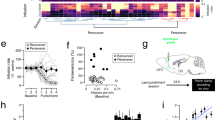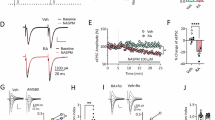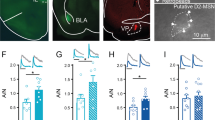Abstract
Dopaminergic and glutamatergic inputs to the nucleus accumbens shell have a central role in reward processing. Non-contingent cocaine administration generates a number of long-term AMPA receptor-dependent changes in synaptic efficacy. However, the synaptic consequences of cocaine self-administration and the potential role of dopamine in these processes remain unclear. Here, we examined the influence of D1 dopamine receptor (D1DR) activation on excitatory synaptic plasticity in the accumbens shell of adult rats following cocaine self-administration. Our results indicated that during the first 2 days following cocaine exposure both pre- and post-synaptic mechanisms contribute to a net decrease in AMPA receptor-mediated signaling. This is reflected by decreased frequency of miniature EPSCs (mEPSCs) attributable to enhanced cannabinoid receptor activity, decreased mEPSC amplitude, and increased paired-pulse ratio of evoked EPSCs. In contrast, the only changes observed in the shell 3–4 weeks following cocaine self-administration were increased mEPSCs amplitudes and AMPA/NMDA ratios. We further found that although these cocaine-induced neuroadaptations during early and late abstinence have different synaptic expression mechanisms, they were normalized by stimulation of D1DRs. Thus, pre-exposure to the D1DR agonist, SKF38393, during the initial period of abstinence increased excitatory synaptic strength, but reduced excitatory signaling after weeks of abstinence. Taken together, these results indicate that the direction of changes in excitatory transmission induced by cocaine self-administration switches over the first few weeks of abstinence. Moreover, D1DRs gate the stability of these cocaine-induced changes at glutamatergic synapses in the accumbens shell by utilizing multiple temporally distinct mechanisms, which has implications for the treatment of cocaine craving and addiction.
Similar content being viewed by others
Log in or create a free account to read this content
Gain free access to this article, as well as selected content from this journal and more on nature.com
or
References
Anderson SM, Famous KR, Sadri-Vakili G, Kumaresan V, Schmidt HD, Bass CE et al (2008). CaMKII: a biochemical bridge linking accumbens dopamine and glutamate systems in cocaine seeking. Nat Neurosci 11: 344–353.
Anderson SM, Pierce RC (2005). Cocaine-induced alterations in dopamine receptor signaling: implications for reinforcement and reinstatement. Pharmacol Ther 106: 389–403.
Andre VM, Cepeda C, Cummings DM, Jocoy EL, Fisher YE, William Yang X et al (2010). Dopamine modulation of excitatory currents in the striatum is dictated by the expression of D1 or D2 receptors and modified by endocannabinoids. Eur J Neurosci 31: 14–28.
Boudreau AC, Ferrario CR, Glucksman MJ, Wolf ME (2009). Signaling pathway adaptations and novel protein kinase A substrates related to behavioral sensitization to cocaine. J Neurochem 110: 363–377.
Boudreau AC, Reimers JM, Milovanovic M, Wolf ME (2007). Cell surface AMPA receptors in the rat nucleus accumbens increase during cocaine withdrawal but internalize after cocaine challenge in association with altered activation of mitogen-activated protein kinases. J Neurosci 27: 10621–10635.
Boudreau AC, Wolf ME (2005). Behavioral sensitization to cocaine is associated with increased AMPA receptor surface expression in the nucleus accumbens. J Neurosci 25: 9144–9151.
Bowers MS, Chen BT, Bonci A (2010). AMPA receptor synaptic plasticity induced by psychostimulants: the past, present, and therapeutic future. Neuron 67: 11–24.
Caille I, Dumartin B, Bloch B (1996). Ultrastructural localization of D1 dopamine receptor immunoreactivity in rat striatonigral neurons and its relation with dopaminergic innervation. Brain Res 730: 17–31.
Chao SZ, Ariano MA, Peterson DA, Wolf ME (2002). D1 dopamine receptor stimulation increases GluR1 surface expression in nucleus accumbens neurons. J Neurochem 83: 704–712.
Conrad KL, Tseng KY, Uejima JL, Reimers JM, Heng L-J, Shaham Y et al (2008). Formation of accumbens GluR2-lacking AMPA receptors mediates incubation of cocaine craving. Nature 454: 118–121.
Crespo JA, Oliva JM, Ghasemzadeh MB, Kalivas PW, Ambrosio E (2002). Neuroadaptive changes in NMDAR1 gene expression after extinction of cocaine self-administration. Ann NY Acad Sci 965: 78–91.
Dobi A, Seabold GK, Christensen CH, Bock R, Alvarez VA (2011). Cocaine-induced plasticity in the nucleus accumbens is cell specific and develops without prolonged withdrawal. J Neurosci 31: 1895–1904.
Dumartin B, Doudnikoff E, Gonon F, Bloch B (2007). Differences in ultrastructural localization of dopaminergic D1 receptors between dorsal striatum and nucleus accumbens in the rat. Neurosci Lett 419: 273–277.
Fernández-Ruiz J, Hernandez M, Ramos JA (2010). Cannabinoid-dopamine interaction in the pathophysiology and treatment of CNS disorders. CNS Neurosci Ther 16: e72–e91.
Ferrario CR, Li X, Wang X, Reimers JM, Uejima JL, Wolf ME (2010). The role of glutamate receptor redistribution in locomotor sensitization to cocaine. Neuropsychopharmacology 35: 818–833.
Ferrario CR, Loweth JA, Milovanovic M, Ford KA, Galinanes GL, Heng LJ et al (2011). Alterations in AMPA receptor subunits and TARPs in the rat nucleus accumbens related to the formation of Ca(2+)-permeable AMPA receptors during the incubation of cocaine craving. Neuropharmacology 61: 1141–1151.
Ghasemzadeh MB, Mueller C, Vasudevan P (2009). Behavioral sensitization to cocaine is associated with increased glutamate receptor trafficking to the postsynaptic density after extended withdrawal period. Neuroscience 159: 414–426.
Haney M, Spealman R (2008). Controversies in translational research: drug self-administration. Psychopharmacology (Berl) 199: 403–419.
Harvey J, Lacey MG (1996). Endogenous and exogenous dopamine depress EPSCs in rat nucleus accumbens in vitro via D1 receptors activation. J Physiol 492 (Pt 1): 143–154.
Hersch SM, Ciliax BJ, Gutekunst CA, Rees HD, Heilman CJ, Yung KK et al (1995). Electron microscopic analysis of D1 and D2 dopamine receptor proteins in the dorsal striatum and their synaptic relationships with motor corticostriatal afferents. J Neurosci 15: 5222–5237.
Hevers W, Lüddens H (2002). Pharmacological heterogeneity of gamma-aminobutyric acid receptors during development suggests distinct classes of rat cerebellar granule cells in situ. Neuropharmacology 42: 34–47.
Johansen PA, Hu XT, White FJ (1991). Relationship between D1 dopamine receptors, adenylate cyclase, and the electrophysiological responses of rat nucleus accumbens neurons. J Neural Transm Gen Sect 86: 97–113.
Jonas P (2000). The time course of signaling at central glutamatergic synapses. News Physiol Sci 15: 83–89.
Kalivas PW, McFarland K (2003). Brain circuitry and the reinstatement of cocaine-seeking behavior. Psychopharmacology 168: 44–56.
Kalivas PW, O’Brien C (2008). Drug addiction as a pathology of staged neuroplasticity. Neuropsychopharmacology 33: 166–180.
Kano M, Ohno-Shosaku T, Hashimotodani Y, Uchigashima M, Watanabe M (2009). Endocannabinoid-mediated control of synaptic transmission. Physiol Rev 89: 309–380.
Kim J, Park BH, Lee JH, Park SK, Kim JH (2011). Cell type-specific alterations in the nucleus accumbens by repeated exposures to cocaine. Biol Psychiatry 69: 1026–1034.
Kourrich S, Rothwell PE, Klug JR, Thomas MJ (2007). Cocaine experience controls bidirectional synaptic plasticity in the nucleus accumbens. J Neurosci 27: 7921–7928.
Kourrich S, Thomas MJ (2009). Similar neurons, opposite adaptations: psychostimulant experience differentially alters firing properties in accumbens core versus shell. J Neurosci 29: 12275–12283.
Kuepper R, Morrison PD, van Os J, Murray RM, Kenis G, Henquet C (2010). Does dopamine mediate the psychosis-inducing effects of cannabis? A review and integration of findings across disciplines. Schizophr Res 121: 107–117.
Levey AI, Hersch SM, Rye DB, Sunahara RK, Niznik HB, Kitt CA et al (1993). Localization of D1 and D2 dopamine receptors in brain with subtype-specific antibodies. Proc Natl Acad Sci USA 90: 8861–8865.
Li X, Hoffman AF, Peng XQ, Lupica CR, Gardner EL, Xi ZX (2009). Attenuation of basal and cocaine-enhanced locomotion and nucleus accumbens dopamine in cannabinoid CB1-receptor-knockout mice. Psychopharmacology (Berl) 204: 1–11.
Lu W, Shi Y, Jackson AC, Bjorgan K, During MJ, Sprengel R et al (2009). Subunit composition of synaptic AMPA receptors revealed by a single-cell genetic approach. Neuron 62: 254–268.
Mameli M, Halbout B, Creton C, Engblom D, Parkitna JR, Spanagel R et al (2009). Cocaine-evoked synaptic plasticity: persistence in the VTA triggers adaptations in the NAc. Nat Neurosci 12: 1036–1041.
Manabe T, Wyllie DJ, Perkel DJ, Nicoll RA (1993). Modulation of synaptic transmission and long-term potentiation: effects on paired pulse facilitation and EPSC variance in the CA1 region of the hippocampus. J Neurophysiol 70: 1451–1459.
Mangiavacchi S, Wolf ME (2004). D1 dopamine receptor stimulation increases the rate of AMPA receptor insertion onto the surface of cultured nucleus accumbens neurons through a pathway dependent on protein kinase A. J Neurochem 88: 1261–1271.
McCutcheon JE, Wang X, Tseng KY, Wolf ME, Marinelli M (2011). Calcium-permeable AMPA receptors are present in nucleus accumbens synapses after prolonged withdrawal from cocaine self-administration but not experimenter-administered cocaine. J Neurosci 31: 5737–5743.
Mcnaughton BL, Barnes CA, Rao G, Baldwin J, Rasmussen M (1986). Long-term enhancement of hippocampal synaptic transmission and the acquisition of spatial information. J Neurosci 6: 563–571.
Moser EI, Krobert KA, Moser MB, Morris RG (1998). Impaired spatial learning after saturation of long-term potentiation. Science 281: 2038–2042.
Mu P, Moyer JT, Ishikawa M, Zhang Y, Panksepp J, Sorg BA et al (2010). Exposure to cocaine dynamically regulates the intrinsic membrane excitability of nucleus accumbens neurons. J Neurosci 30: 3689–3699.
Murase K, Ryu PD, Randic M (1989). Excitatory and inhibitory amino acids and peptide-induced responses in acutely isolated rat spinal dorsal horn neurons. Neurosci Lett 103: 56–63.
Nicola SM, Kombian SB, Malenka RC (1996). Psychostimulants depress excitatory synaptic transmission in the nucleus accumbens via presynaptic D1-like dopamine receptors. J Neurosci 16: 1591–1604.
Parolaro D, Rubino T (2008). The role of the endogenous cannabinoid system in drug addiction. Drug News Perspect 21: 149–157.
Patel S, Rademacher DJ, Hillard CJ (2003). Differential regulation of the endocannabinoids anandamide and 2-arachidonylglycerol within the limbic forebrain by dopamine receptor activity. J Pharmacol Exp Ther 306: 880–888.
Pennartz CM, Dolleman-Van der Weel MJ, Kitai ST, Lopes da Silva FH (1992). Presynaptic dopamine D1 receptors attenuate excitatory and inhibitory limbic inputs to the shell region of the rat nucleus accumbens studied in vitro. J Neurophysiol 67: 1325–1334.
Pierce RC, Kumaresan V (2006). The mesolimbic dopamine system: the final common pathway for the reinforcing effect of drugs of abuse? Neurosci Biobehav Rev 30: 215–238.
Pisani V, Madeo G, Tassone A, Sciamanna G, Maccarrone M, Stanzione P et al (2011). Homeostatic changes of the endocannabinoid system in Parkinson's disease. Mov Disord 26: 216–222.
Ramiro-Fuentes S, Ortiz O, Moratalla R, Fernandez-Espejo E (2010). Intra-accumbens rimonabant is rewarding but induces aversion to cocaine in cocaine-treated rats, as does in vivo accumbal cannabinoid CB1 receptor silencing: critical role for glutamate receptors. Neuroscience 167: 205–215.
Ryman-Rasmussen JP, Nichols DE, Mailman RB (2005). Differential activation of adenylate cyclase and receptor internalization by novel dopamine D1 receptor agonists. Mol Pharmacol 68: 1039–1048.
Sara Y, Bal M, Adachi M, Monteggia LM, Kavalali ET (2011). Use-dependent AMPA receptor block reveals segregation of spontaneous and evoked glutamatergic neurotransmission. J Neurosci 31: 5378–5382.
Schilström B, Yaka R, Argilli E, Suvarna N, Schumann J, Chen BT et al (2006). Cocaine enhances NMDA receptor-mediated currents in ventral tegmental area cells via dopamine D5 receptor-dependent redistribution of NMDA receptors. J Neurosci 26: 8549–8558.
Schmidt HD, Anderson SM, Pierce RC (2006). Stimulation of D1-like or D2 dopamine receptors in the shell, but not the core, of the nucleus accumbens reinstates cocaine-seeking behaviour in the rat. Eur J Neurosci 23: 219–228.
Schmidt HD, Pierce RC (2010). Cocaine-induced neuroadaptations in glutamate transmission. Ann NY Acad Sci 1187: 35–75.
Schramm-Sapyta NL, Olsen CM, Winder DG (2006). Cocaine self-administration reduces excitatory responses in the mouse nucleus accumbens shell. Neuropsychopharmacology 31: 1444–1451.
Schumann J, Yaka R (2009). Prolonged withdrawal from repeated noncontingent cocaine exposure increases NMDA receptor expression and ERK activity in the nucleus accumbens. J Neurosci 29: 6955–6963.
Self DW, Nestler EJ (1995). Molecular mechanisms of drug reinforcement and addiction. Annu Rev Neurosci 18: 463–495.
Stell BM, Mody I (2002). Receptors with different affinities mediate phasic and tonic GABA(A) conductances in hippocampal neurons. J Neurosci 22: RC223.
Thomas MJ, Beurrier C, Bonci A, Malenka RC (2001). Long-term depression in the nucleus accumbens: a neural correlate of behavioral sensitization to cocaine. Nat Neurosci 4: 1217–1223.
Wolf ME (2010). The Bermuda Triangle of cocaine-induced neuroadaptations. Trends Neurosci 33: 391–398.
Wolf ME, Ferrario CR (2010). AMPA receptor plasticity in the nucleus accumbens after repeated exposure to cocaine. Neurosci Biobeh Rev 35: 185–211.
Xi ZX, Gilbert JG, Peng XQ, Pak AC, Li X, Gardner EL (2006). Cannabinoid CB1 receptor antagonist AM251 inhibits cocaine-primed relapse in rats: role of glutamate in the nucleus accumbens. J Neurosci 26: 8531–8536.
Yung KK, Bolam JP, Smith AD, Hersch SM, Ciliax BJ, Levey AI (1995). Immunocytochemical localization of D1 and D2 dopamine receptors in the basal ganglia of the rat: light and electron microscopy. Neuroscience 65: 709–730.
Acknowledgements
This work was supported by NIH Grants R01 DA22339 and K02 DA18678 to RCP.
Author information
Authors and Affiliations
Corresponding author
Ethics declarations
Competing interests
The authors declare no conflict of interest.
Rights and permissions
About this article
Cite this article
Ortinski, P., Vassoler, F., Carlson, G. et al. Temporally Dependent Changes in Cocaine-Induced Synaptic Plasticity in the Nucleus Accumbens Shell are Reversed by D1-Like Dopamine Receptor Stimulation. Neuropsychopharmacol 37, 1671–1682 (2012). https://doi.org/10.1038/npp.2012.12
Received:
Revised:
Accepted:
Published:
Issue date:
DOI: https://doi.org/10.1038/npp.2012.12
Keywords
This article is cited by
-
High frequency DBS-like optogenetic stimulation of nucleus accumbens dopamine D2 receptor-containing neurons attenuates cocaine reinstatement in male rats
Neuropsychopharmacology (2023)
-
Cocaine induces input and cell-type-specific synaptic plasticity in ventral pallidum-projecting nucleus accumbens medium spiny neurons
Neuropsychopharmacology (2022)
-
Basolateral amygdala CB1 receptors gate HPA axis activation and context-cocaine memory strength during reconsolidation
Neuropsychopharmacology (2021)
-
Cell-type and region-specific nucleus accumbens AMPAR plasticity associated with morphine reward, reinstatement, and spontaneous withdrawal
Brain Structure and Function (2019)
-
Dopamine and addiction: what have we learned from 40 years of research
Journal of Neural Transmission (2019)



